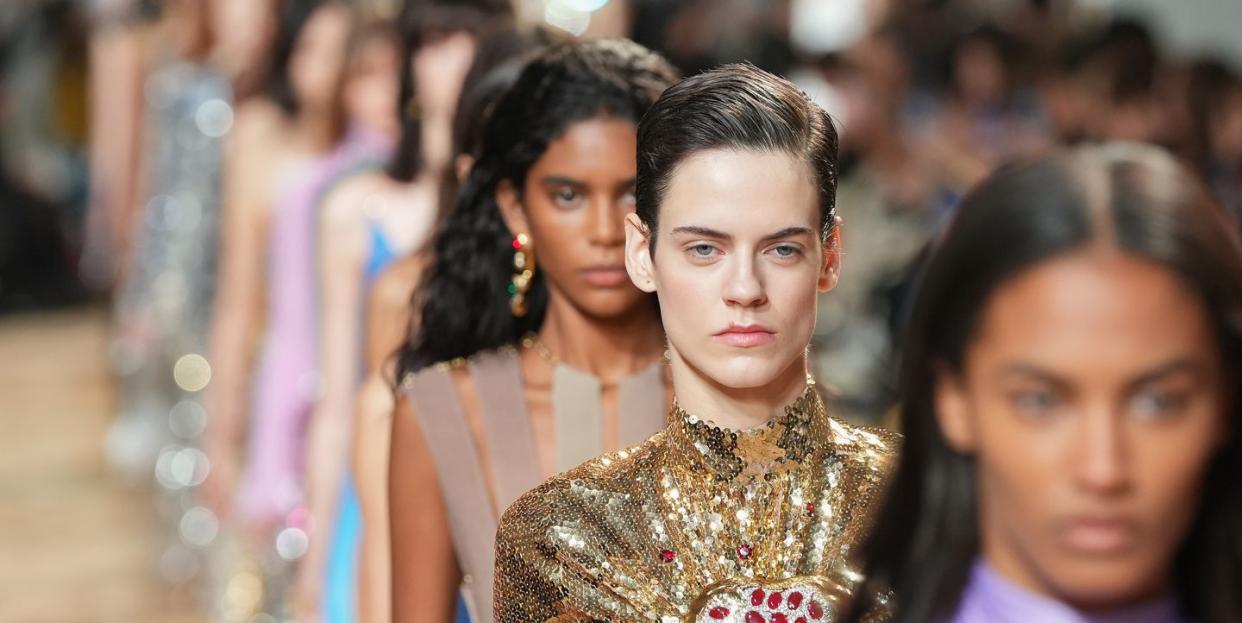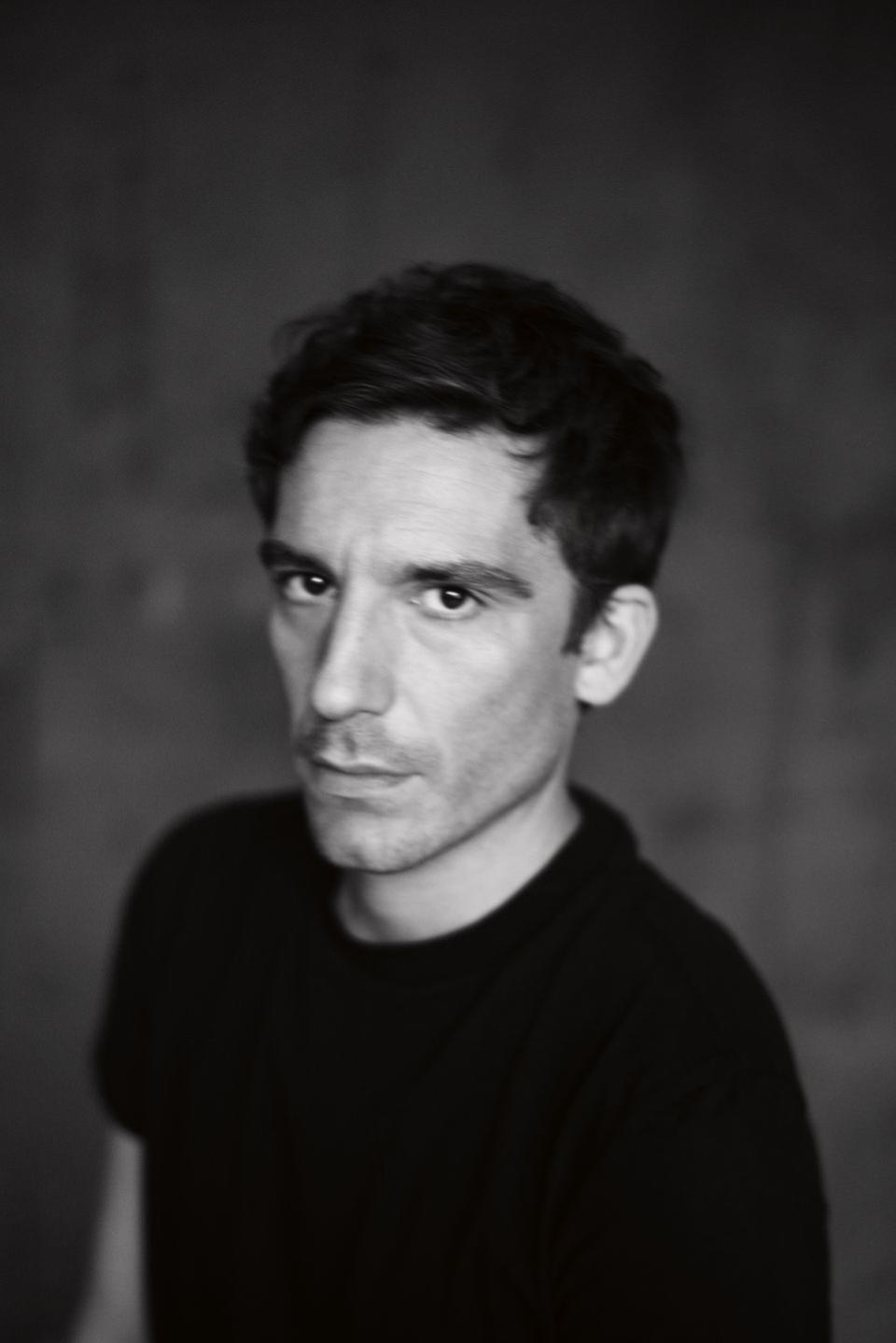Extravagant Clothes for Independent Women

- Oops!Something went wrong.Please try again later.
- Oops!Something went wrong.Please try again later.
There’s nothing quite like the feeling of one of Julien Dossena’s dresses against your skin. In the front row of his Paco Rabanne show on Wednesday afternoon—he has been the creative director there for a decade now—the actress Jemima Kirke was recounting how she'd tried on one of his metal creations, done in expert deference to Rabanne’s unorthodox, space-age creations, in the atelier the day before. “It was freezing,” she said. Though she sounded sort of titillated by the experience. (She ended up wearing a knit gold-and-silver crop top and matching long skirt by the brand instead, and appeared quite comfortable.)
This is Dossena’s signature key: his clothes are exciting and often confusing, and decidedly erotic. Like Rabanne, he uses plastic, chainmail, and metal, his atelier attaching shimmering discs and fringe blades by hand using small silver rings. But even when he ventures into other materials, the effect is thrilling. At a time when everything looks plucked from the Instagram moodboard, Dossena makes clothes that are provocative and, in description, seem like they shouldn’t quite work—like Fall 2023’s busy orange floral prints tiered between dense black lace on a gown, or beige plush wrapped around the shoulders like tentacles from a bad dream. And yet they look absolutely come hither.
“That relationship between the body and this kind of material, for [Rabanne], it was what he found almost fetishistic,” Dossena said in a conversation in late February. It was also the moment of the sexual revolution—Rabanne first emerged in the 1960s, and died earlier this year—and “women were acknowledging their bodies in a different way, and [there was] that freedom of sexuality, and the choice to be desirable in a new way.” Dossena’s description of Rabanne’s first moment of success sounds not unlike our present day, with women gravitating towards sexier or even more aggressive clothes.
It’s perhaps this quality that has put Dossena’s name in the mix for a role at a larger house, like Givenchy, where Matthew Williams’s contract is soon due to expire. Regardless, Dossena has made Paco Rabanne the go-to brand for women who want something unusual but extravagant. Moda Operandi founder Lauren Santo Domingo, who often wears Paco herself, says the clothes sell briskly on her site: “There is such demand that we launched an exclusive capsule of Julien’s signature chainmail, scratch lace, and jacquard knits recolored in white in October, with many styles selling out within days of launch.”
In the audience were industry power players and fellow designers, like Louis Vuitton artistic director Nicolas Ghesquiere (under whom Dossena worked at Balenciaga), shoe designer Pierre Hardy, and Jean Paul Gaultier. (The presence of Gaultier added another layer of intrigue—could Dossena be the next designer in Gaultier’s rotating cast of guest couturiers?)

Whether he’s headed elsewhere or not, Dossena this season is poised to elevate himself to a new level of fashion infamy. In a sea of increasingly anodyne and wearable high-fashion, Dossena goes his own way. Guests at the Wednesday show who were dressed in Rabanne clanged up and down the plush-lined runway beforehand taking selfies with fellow Rabanne-clad attendees. My seatmate, Lisa Rinna, laughed about the impracticalities of wearing a short suit whose fabric resembled upholstery, covered in a layer of vinyl. But when the show began and the cut-out tangerine-orange gowns bedazzled with pomegranate hearts began coming down the runway, she was gasping with desire. As Santo Domingo put it of Dossena’s work, “I find that while Julien’s clothing are fashion-forward to say the least, they are easy to wear, with both the quality and fit being spot on.”
Working in the atelier, Dossena and his team aim for “that lightness, that easiness. For it not to be a costume, but for it to be a real dress.” But they are also one of the few fashion houses motivated by novelty and experimentation. “You have always to experiment and to explore and to search with your teams how to get that feeling of newness, I would say, or how to work a new material.” Those fur-like tentacle pieces, for example, were actually made out of a deep-pile, super hairy wool. “There is a sewing machine for sure, because there are some pieces in fabric too. But a lot of it is like, basically there is no machine. It's really by hand most of the time. It's really a craftsmanship that is, let’s say, inherent to the house. There are a lot of people here opening the rings and putting the elements together and engineering.”
When he arrived, there was still one worker in the atelier who had worked with Rabanne himself, and helped Dossena perfect his metal mesh technique. Otherwise, it’s Dossena and young fashion school graduates figuring out how to work with unorthodox materials. “I have seen some really young people coming from school a few years ago that now are at the top of the chain mail atelier, let’s say. And they learn on the web. They learned a lot from the archive, also. It’s a real creation every time, depending on the material and the shape of the element that we’re gonna use to make that dress. It’s really engineering.”
If they might learn more traditional techniques at other Parisian ateliers, his employees prefer to “be a little bit punkish” and learn about hammering and stringing things together instead.
The Fall 2023 collection found its footing in a performance between Rabanne and Salvador Dalí, who were longtime friends. (Allegedly, Spanish-born Dalí once called Spanish-born Rabanne “the second best Spanish artist”—after himself.) Surrealism is a theme that’s attracted a number of designers lately, from Jonathan Anderson at Loewe to Daniel Roseberry’s Schiaparelli, but Dossena managed to make it feel distinct. Most impressive were a quartet of dresses printed with Dalí paintings, made with the cooperation of the Fundació Gala-Salvador Dalí, which stretched and distorted over imperious cape-back gowns. (They were actually classy enough to be award show dress contenders.) The idea was that the dress would look as though “it was cut from the painting of Dalí,” Dossena explained, an amusingly incendiary idea that recalls the “creative freedom” and “radical modernity” Dossena admired in both Rabanne and Dalí.
Dossena is eager to emphasize the couture quality of much of his output, especially the chainmail, which is now a material used widely in fashion. “Working at Paco, I really put pressure on myself to be the best at that, you know?” But what he seeks most of all is “to make it relevant.”
“Because it can go super easy in this kind of sci-fi film, costume [feeling]. So how to make it really relevant in the story of the show, for example, or in the present?”
The sheer number of women gleefully dressed in the designer’s goods suggested he’s well on his way. He mused towards the end of our conversation on how he thinks about designing for a woman, as a man. “I’m trying to help women, as much as I can, to be, at a special moment, the exact woman they want to be. The incarnation of a strong woman, with independent confidence. And of course, taking care of the body of the woman. I never want them to be vulnerable, especially in the world right now."
You Might Also Like

